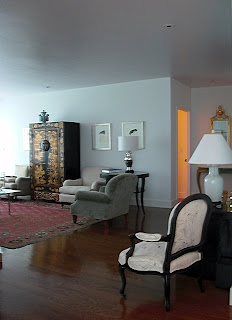 .... that we still value.
.... that we still value.The Ambassadors, painted by Hans Holbein the Younger in 1533, is a fascinating work from a decorator's point of view. The symbolism of the objects apart, what is of interest to a decorator are the fabric of the garments, the hangings, the carpet and the floor.
First, the carpet, known as a Holbein carpet, perhaps for obvious reasons, is 16th century Ushak, with a pattern of squares, octagons, or stars. The Holbein carpet is one of many depictions of Turkish carpets and rugs in paintings for in the way that Holbein lent his name to a style of carpet so too did the artist Lorenzo Lotto. The Lotto carpet, made in the in the 16th and 17th centuries along the Agean coast of Anatolia, was depicted at least ten times by Lorenzo Lotto in his work.
The hangings and the clerical robe of the man on the right are made of the same ancient weave that we still value highly today. Apparently first made in China, India, Persia and Syria, used in Byzantium and came to the West where it was first known by its Byzantine name of diaper. Damascus, in the 12th century was so famous for the beauty of its textiles that it gave the cloth its modern name, damask.
The floor is what is known as a Cosmati pavement named for a Roman family of marble craftstmen working during the 12th and 13th centuries, who created floors and wall decorations in geometrical patterns by reusing marble stripped from ancient Roman ruins.
A Cosmati floor would be stunning in any modern building, especially a residence. Would one need a Holbein or a Lotto carpet on the floor? Maybe not, but why not show that carpet the respect it deserves by draping it as Holbein did on a table or against a wall? Could one use such large scale damask as wall hangings nowadays? Perhaps a superb alternative to the standard two coats of latex.
Why not?
Three ingredients for a wonderful contemporary interior using ambassadors from the past.
To be continued.






















